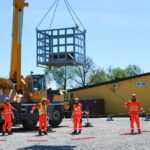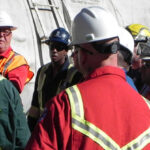
Safe lifting operations depend on the selection of suitable personnel who are competent to carry out the required duties.
Those responsible for the selection should ensure that the personnel involved in the lifting operations are efficiently organized in order to ensure good team work during the lifting operations.
Under the Lifting Operations and Lifting Equipment Regulations 1998 (LOLER), an employer must ensure that each lifting operation is planned and carried by a competent person.
A competent person is a person who has such practical and theoretical knowledge and experience of the lifting equipment used in the lifting operation as is necessary to carry out the required duties.
In this blog, we are going to highlight the duties and responsibilities of competent personnel involved in lifting operations.
Duties of an Appointed Person in Lifting Operations
The appointed person’s duties should include the following.
- The assessment of the lifting operation to provide such planning, selection of crane(s), lifting gear and equipment, instruction and supervision as is necessary for the task to be undertaken safely.
- Consultation with other responsible bodies or technical authorities if necessary and ensuring that where different organizations are involved they collaborate as necessary.
- Ensuring that adequate inspection and maintenance of the lifting equipment has been carried out.
- Ensuring that there is an effective procedure for reporting defects and incidents and taking any necessary corrective action.
- Responsibility for the organization and control of the lifting operation.
- Ensuring that the lifting supervisor is fully briefed on the contents of the method statement.
The appointed person should be given the necessary authority for the performance of all these duties and, in particular, authority to stop the lifting operation whenever he considers that danger is likely to arise if the operation were to continue.
Duties of Lifting Supervisor for Lifting Operations
The lifting supervisor’s duties should include the following.
- Carrying out a site survey to check that there have been no significant changes or additional hazards introduced from those identified in the lift plan.
- Checking the access and egress routes of the crane from the lifting area.
- Checking the load(s) to be lifted match the descriptions on the lift plan.
- Checking that the crane and any lifting attachments provided match those selected in the lift plan, including the lifting capacities and physical dimensions of the crane.
- Checking that the lifting accessories selected in the lift plan are present.
- Checking reports of thorough examination for the crane, lifting attachments and accessories.
- Checking that pre-use checks have been undertaken by the crane operator and the riggers.
- Checking that an exclusion zone (barricades) has been established around the lifting area.
- Briefing the lifting team (rigger, banksman and operator) on the details of the lift plan.
- Supervising the siting and setting up of the crane in preparation for the lifting operation.
- Checking that the crane has been set up in accordance with the lift plan.
- Supervising the lifting operation.
Duties of Crane Operator for Lifting Operations
- Reviewing the requirements for the crane with the lifting supervisor before operations.
- Knowing what types of site conditions could adversely affect the operation of the crane and consulting with the lifting supervisor concerning the possible presence of those conditions.
- Understanding and applying the information contained in the crane manufacturer’s operating manual.
- Understanding the crane’s functions and limitations as well as its particular operating characteristics.
- Using the crane’s load rating chart(s) and diagrams and applying all notes and warnings related to the charts to confirm the correct crane configuration to suit the load, site, and lift conditions.
- Refusing to operate the crane when any portion of the load or crane would enter the prohibited zone or close proximity hazards.
- Performing a daily inspection of the crane before use.
Banksman’s Duties in Lifting Operations
The role of a banksman is required in offshore and onshore lifting operations and these involve the following duties:
- Ensure that he is easily identifiable from other personnel by wearing a hi-vis jacket or reflective vest which is clearly marked to indicate that he is an authorised banksman or signal person.
- Ensure that both he and the crane operator are aware of all aspects of the lifting operation to be undertaken.
- Ensure that both he and the crane operator have agreed and are familiar with the method of signalling to be used. All signalling must be conducted in a clear and concise manner.
- Check cargo manifests and reviewing weight of the load with the crane operator and rigger.
- Be familiar with the capacities and parameters of the crane in use for the lifting operations.
- Check that the lifting gears being used are in good condition, certified for use, correctly colour coded and of sufficient capacity to carry out the lift.
- Always use clear and distinct signals (either by hand or by radio) to control lifting operations.
- When lifting, stop the load just clear of the deck to check balance and security of load. This will also give the crane operator the opportunity to check the function of his hoist brake.
- Warn other personnel in the area of the movement of the load. Avoid moving the load over the heads of other personnel.
- Make it clear to the crane operator where the load has to be moved to and placed. Ensure the receiving landing area has sufficient room to take the load.
Rigger’s Duties in Lifting Operations
A rigger uses fixed and portable lifting equipment and accessories to locate loads to a position to allow final installation or fixing or move loads to a position where they are accessible to a crane in accordance the lifting plan.
The following duties are carried out by rigger during lifting operations.
- Utilize appropriate rigging gears suitable for lifting operations
- Utilize the rigging gears within industry standards and manufacturer’s recommendations
- Conduct regular inspection and maintenance of the rigging gears.
- Participates in job hazard analysis and tool box talk for the lift.
- Attach loads to rigging to provide support or prepare them for moving, using hand and power tools.
- Attach pulleys and blocks to fixed overhead structures such as beams, using bolts and clamps.
- Control movement of heavy equipment through narrow openings or confined spaces.
- Dismantle and store rigging equipment after use.
The lifting operation planning and execution should be undertaken by personnel who is competent. It is essential that any competent personnel assigned to planning and execution should undertake appropriate lifting operations training to ensure they are able to perform their job safely.
Primelift Safety Resources Limited provides lifting operations training to ensure the competency of personnel.
Contact us on www.primeliftsafetyng.com. Call us on +2348037957878 or Email us at training@primeliftsafetyng.com.










